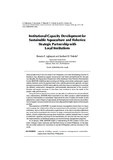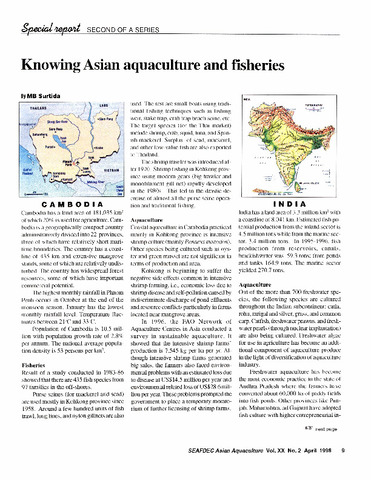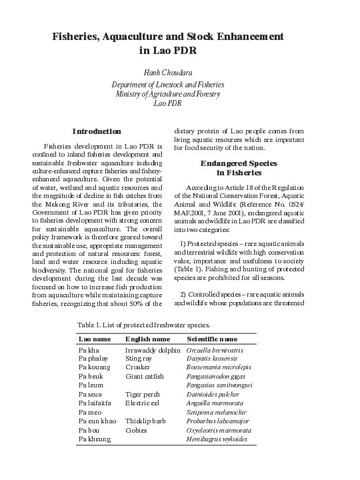Sustaining aquaculture by developing human capacity and enhancing opportunities for women
- Global styles
- MLA
- Vancouver
- Elsevier - Harvard
- APA
- Help

Download URL
www.fao.orgDate
2012Author
Page views
2,662ASFA keyword
Metadata
Show full item record
Share
Abstract
People are at the heart of sustaining aquaculture. Development of human capacity and gender, therefore, is an important human dimension. Human capacity development (HCD) was a major thrust of the 2000 Bangkok Declaration and Strategy, but gender was not addressed. The Food and Agriculture Organization of the United Nation's (FAO) Strategic Framework for Human Capacity Development (HCD) emphasized building human capacity in a coherent fashion at four levels - in individuals, organizations, sectors/networks and in the overall enabling environment. Although strategic HCD in aquaculture has not received attention, substantial HCD has occurred in aquaculture education and training. Aquaculture departments in universities, aquaculture research institutes, networks and professional societies all include training as central activities.
Women are active participants in aquaculture supply chains, but a dearth of gender-disaggregated information hampers accurate understanding of their contribution. Research results and FAO National Aquaculture Sector Overview (NASO) fact sheets show that female participation rates vary by type and scale of enterprise and country. Women are frequently active in hatcheries and dominate fish processing plant labourers. Women's work in small-scale aquaculture frequently is unrecognized, under or unpaid. Most aquaculture development projects are not gender sensitive, and aquaculture success stories often do not report gender dimensions; projects can fail if their designs do not include gender.
Lacking gender-disaggregated data on participation rates and trends in education, we conducted a preliminary survey of aquaculture tertiary institutes in Africa, Asia, Europe and North America. The percentage of female graduates in aquaculture increased considerably over the last four decades, from zero or low numbers in the 1970s to recent rates of around 30-60 percent; rates vary both by country and within countries. No data are available to track whether female graduates are entering successful careers in aquaculture. To accelerate HCD to meet the needs of aquaculture growth, commodity and theme priorities for HCD must be established. Educational institutions should cooperate and harmonize work programmes and overcome language barriers. Aquaculture education needs the best students and should help prepare them for rewarding careers. More social science content is needed in aquaculture curricula to groom graduates for management and leadership roles. The gender balance in aquaculture faculty could be improved by recruiting and retaining more women.
Gender should be put firmly on the policy agenda and built into normative instruments, old and new, complemented by the collection of gender-disaggregated data for aquaculture supply chains. Women should be empowered through gender equity in access to financial, natural, training and market resources. Women in aquaculture should not be stereotyped as 'small-scale' and poor. Women are often hampered by systemic barriers such as lack of legal rights. Women should be encouraged to build their management, leadership and entrepreneural skills. In circumstances where rural men have migrated for work, small-scale aquaculture has proven a suitable livelihood option to reduce the pressure on women. Because postharvest processing and fish trade are feminized occupations, gender equity deserves special attention in fair trade and fish certification schemes. HCD and gender are receiving more attention in rehabilitation efforts to assist survivors from disease and natural disasters.
Suggested Citation
Williams, M. J., Agbayani, R., Bhujel, R., Bondad-Reantaso, M. G., Brugère, C., Choo, P. S., … Xu, P. (2012). Sustaining aquaculture by developing human capacity and enhancing opportunities for women. In R. P. Subasinghe, J. R. Arthur, D. M. Bartley, S. S. De Silva, M. Halwart, N. Hishamunda, … P. Sorgeloos (Eds.), Farming the Waters for People and Food. Proceedings of the Global Conference on Aquaculture 2010, Phuket, Thailand, 22-25 September 2010 (pp. 785-822). Rome: FAO; Bangkok: NACA.
Type
Conference paperISBN
9789251072332Collections
- Conference Proceedings [299]
Related items
Showing items related by title, author, creator and subject.
-
Institutional capacity development for sustainable aquaculture and fisheries: Strategic partnership with local institutions
Agbayani, Renato F.; Toledo, Joebert D. (Terrapub, 2008)Many people living in the rural areas in the Philippines, as in other developing countries in Southeast Asia, depend on aquatic resources for their food and livelihood. For the past two decades, the Aquaculture Department ... -
Knowing Asian aquaculture and fisheries
Surtida, Marilyn B. (Aquaculture Department, Southeast Asian Fisheries Development Center, 1998-04)This article is the second of four parts. -
Fisheries, aquaculture and stock enhancement in Lao PDR
Choudara, Hanh (Aquaculture Department, Southeast Asian Fisheries Development Center, 2006)Fisheries development in Lao PDR is confined to inland fisheries development and sustainable freshwater aquaculture including culture-enhanced capture fisheries and fishery-enhanced aquaculture. Given the potential of ...




